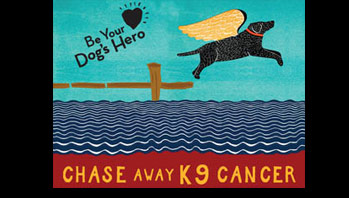The Chase Away K9 Cancer fund is held within the National Canine Cancer Foundation. All of the profits from events and sales of Chase items goes to fund K9 cancer studies and help to raise K9 cancer awareness. We are Proudly 100% volunteer driven to help “Chase Away K9 Cancer” thank you to all that continue to donate and believe that we can make a difference in our pets lives.
Grant No. LT15WI-003 | Discovering genetic and environmental risk factors for bladder cancer in dogs
Principle Investigator:
Lauren Trepanier, DVM, PhD, DACVIM, DACVCP
Professor of Internal Medicine
Department of Medical Sciences, School of Veterinary Medicine
University of Wisconsin-Madison
Amount of Grant:
Year 1: $38,061.00
Year 2: $41,642.00
THIS GRANT HAS BEEN 100% FUNDED THROUGH DONATIONS AND SUPPORT FROM THE CHASE AWAY K9 CANCER FUND.
Title:
Discovering genetic and environmental risk factors for bladder cancer in dogs
Abstract:
Bladder cancer (transitional cell carcinoma, TCC) accounts for up to 2% of all canine cancers, and often leads to euthanasia. However, the causes and individual risk factors for this disease are not understood. Human bladder cancer is associated with environmental chemicals such cigarette smoke, industrial pollution, herbicides and pesticides, and arsenic in well water. In dogs, bladder cancer has been associated with older flea and tick dips and some lawn herbicides. However, the predilection for certain breeds such as Scottish terriers, along with these environmental associations, suggest a gene-environment interaction for this cancer in dogs.
Bladder cancer risk in humans is influenced by genetic variation in GSTT1 and GSTM1, which are glutathione- S-transferase (GST) enzymes that detoxify environmental carcinogens. In dogs, only the GSTT1 enzyme has been evaluated to any extent, with 12% of dogs showing very low GSTT1 expression; canine GSTM1 has not yet been characterized. We hypothesize that genetic variants in canine GSTT1 and GSMT1 interact with specific environmental chemicals to increase bladder cancer risk in dogs. The specific aims of this proposal are to determine whether GSTT1 and GSTM1 variants are over-represented in dogs with bladder TCC, compared to age- and breed-matched controls, and to determine whether exposures to aromatic amines, polycyclic aromatic hydrocarbons, herbicides/pesticides, or well water are risk factors for bladder cancer in dogs, particularly when GSTT1 and GSTM1 genotypes are considered.
We will address these aims by resequencing canine GSTT1 and GSTM1 from buccal swab genomic DNA obtained from affected and control dogs. In addition, we will assess environmental exposures over the previous year for both groups using a targeted client questionnaire. Our team includes a veterinary epidemiologist who is a leader in bladder cancer risk studies, a veterinary oncologist who is a leader in clinical trials in canine TCC, a scientist with expertise in predictive models of gene variants, and a statistical geneticist with expertise in evaluating complex gene interactions.
The long-term objective of this study is to identify specific genetic and environmental risk factors for bladder cancer in dogs, so that dog owners can be offered rational screening and cancer prevention and strategies.
Grant No. AB15MN-002 | Preclinical Evaluation and Clinical Translation of Novel Bispecific Targeted Toxins for the Treatment of Sarcomas
Principle Investigator:
Antonella Borgatti, DVM
Assistant Clinical Professor of Oncology
Veterinary Clinical Sciences
University of Minnesota
Amount of Grant:
Year 1: $78,016.00
Year 2: $73,935.00
THIS GRANT HAS BEEN 100% FUNDED THROUGH DONATIONS AND SUPPORT FROM THE CHASE AWAY K9 CANCER FUND.
Title:
Preclinical Evaluation and Clinical Translation of Novel Bispecific Targeted Toxins for the Treatment of Sarcomas
Abstract:
Canine hemangiosarcoma (HSA) is a lethal disease typically arising from the spleen and for which there are no effective treatments. The expected survival for dogs with HSA treated with standard of care therapy is less than 6 months and only 10-15% survive a year or longer. There has been increasing interest in developing novel agents that can specifically target growth factor pathways with reduced toxicity. We developed a bispecific ligand targeted toxin called EGFuPA designed to simultaneously target the epidermal growth factor receptor (EGFR), which is upregulated in a variety of cancers (1), and the urokinase receptor (uPAR), which is expressed on sarcomas, endothelial cells, and tumor vasculature (2). EGF and uPA are conjugated to a truncated Pseudomonas exotoxin (PE) A, with potent anticancer activity via inhibition of protein synthesis (3-5). EGFuPA has shown exquisite activity to kill chemoresistant canine HSA cells, as well as HSA tumor initiating cells at clinically achievable concentrations (6). Additionally, EGFuPA can target tumor cells and the associated vasculature in vivo with high specificity (7). Our goal is to identify an optimal, safe and effective dose of EGFuPA to treat canine hemangiosarcoma in a clinical trial using a continuous reassessment model. We designed and initiated SRCBST, a Phase l/ll Bayesian dose-finding trial enrolling dogs with non-metastatic splenic HSA to test the hypothesis that EGFuPA is a safe and effective adjunct to standard care to treat chemoresistant, highly metastatic hemangiosarcoma in dogs. Our specific aim is to determine the activity, toxicity, and optimal dose of EGFuPA in dogs with hemangiosarcoma when given as an adjunct to standard of care surgery (splenectomy) and doxorubicin chemotherapy. We have enrolled 16 dogs thus far and our current funding is sufficient to enroll up to 20 dogs. While the estimates of dose limiting toxicities (<10%) and six-month survival (90%) for the current optimal dose (50 ug/kg) are promising, we have determined that a sample size of 30 dogs will enable us to increase the precision with which we can estimate the occurrence of dose-limiting toxicity, establish an expectation for efficacy, and identify biomarkers for likely responders.
Grant No. DT06PA-001 | Therapeutic inhibition of angiogenesis in canine tumors
Principle Investigator:
Andrei Thomas-Tikhonenko, Ph.D.
Chair, Cancer Biology Graduate Program
Chief, Division of Cancer Pathobiology
Department of Pathobiology
University of Pennsylvania
The National Canine Cancer Foundation has restructered this grant with Dr. Modiano. Instead of one large grant, we are funding the entire study in a series of smaller grants so that we can move the research ahead in a more expedient manner. Listed below are the grants funded and the most recent in the series of grants to be funded.
First in the Series of Grants
Amount of Grant:
$150,000 THIS GRANT HAS BEEN FULLY FUND THROUGH DONATIONS AND SUPPORT FROM THE BRUISER 5K FUND, THE LANCE MEMORIAL FUND, THE TEXAS SHOOT OUT, CHASE AWAY K9 CANCER FUND AND DONATIONS FROM OUR SUPPORTERS.
Title:
Therapeutic inhibition of angiogenesis in canine tumors.
Abstract:
During the last decade, human medicine has witnessed the emergence of the new generation of cancer drugs, which were rationally designed to block pathways crucial to tumor growth. One eloquent example is the inhibitors of angiogenesis (the ingrowth of new blood vessels into the tumor). All tumors need a blood supply to provide rapidly dividing cancerous cells with oxygen and nutrients. The task of generating new vessels is two-fold: it requires an increased production of pro-angiogenic molecules and a decreased production of anti-angiogenic molecules. The chief proangiogenic molecule is a protein called VEGF (for Vascular Endothelium Growth Factor.) The chief anti-angiogenic molecule is a protein called TSP (for ThromboSPondin.) That most tumors go to extraordinary lengths to overproduce VEGF and silence TSP attests to the significance of these molecules.
In our proposal we will focus on three complementary Aims.
1. To generate canine “VEGF trap” proteins capable of binding and sequestering this pro-angiogenic factor. This will be achieved by artificially truncating naturally occurring cell membrane-bound form of VEGF sensors (known as VEGF receptors). The truncated forms typically do not possess pro-angiogenic activities. Instead they channel VEGF into dead-end protein-protein interactions.
2. To test anti-angiogenic activities of polypeptides based on the canine thrombospondin-1 protein. Experimental tumors will be treated with either polypeptides themselves or DNA fragments encoding such peptides.
3. To identify molecules capable of re-activate endogenous (tumor-produced) thrombospondin.
Two classes of molecules are under investigation:
a) compounds that directly increase the half-life of thrombospondin-1 messenger RNA; b) compounds that increase the half-life of the protein called p53, which is the major activator of thrombospondin.
By the end of the 3d year of NCCF-funded research, we expect to have begun clinical trials involving at least some of these newly developed therapeutics. By the very nature of anti-angiogenic compounds, they can be applied towards a wide range of common canine neoplasms ranging from Hemangiosarcoma to breast cancers to B-lymphomas, which collectively account for the majority of cancer-related deaths in dogs.






